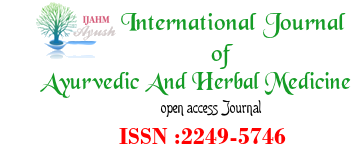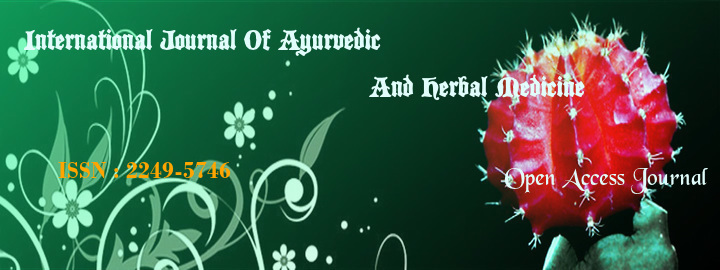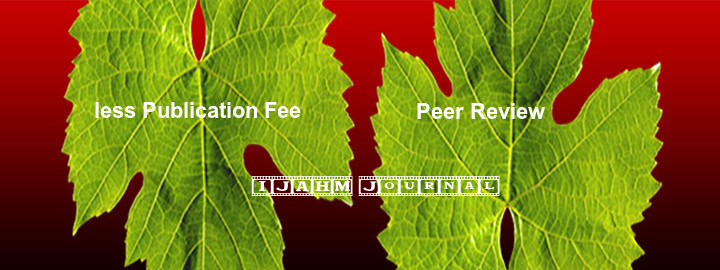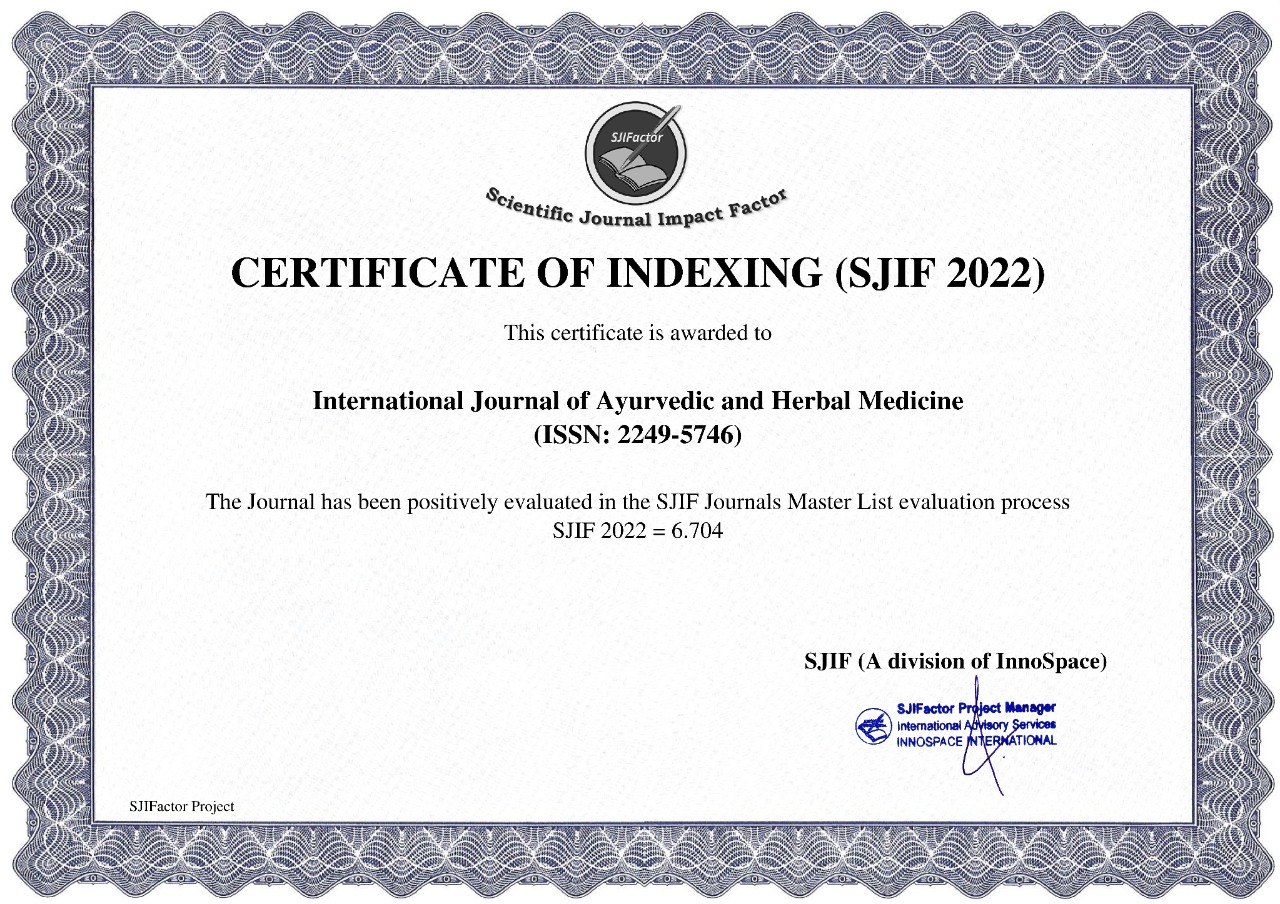


Dr.Sreekumar.K1 , Dr.Nawfya.M.A2
1. Assistant prof. Dept. of Shalakyatantra, Govt. Ayurveda College, Tripunithura.
2nd year M.D Scholar, Dept. of Panchakarma, Govt. Ayurveda College, Tripunithura.
Abstract
The existence of indigenous science of health termed Ayurveda since ancient times, because of its solid background in the form of its fundamental and basic principles advanced on the basis of doctrines of Indian philosophy. Carakacharya in Vimanasthana states two types of examination for wise; Pratyaksha and Anumana. These two combined with instructions (Apthopadesa) constitute the method of examination (Pareeksha). Among the 4 Pramanas, Aptopadesa, Pratyaksha, Anumana and Yukthi, mentioned in Caraka samhitha Sutrastana; Anumana is the most beneficial in clinical research even though it is based on prior Pratyaksha. It is of three types and is related to three times; past, present and future. According to oxford dictionary, research is the systemic investigation into and study of materials and sources in order to establish facts and reach new conclusions. The concept of applying logical reasoning in solving problems or answering questions appear to have originated with process of deductive reasoning employed a logical syllogism consisting of two or more premises or propositions followed by a conclusion. So classical methods of research are not only accepting a general principle from logic but also proving its application for each fact through Pramanas. Nyaya darsana describes Anumana as the act of inferring i.e. something unknown from known data. The inferential knowledge is preceded by perception (Pratyaksha) in one’s own mind (Swarthanumana) through a five membered syllogism, convincing others (Pararthanumana). The process being undertaken within framework of set of approaches including the five membered syllogisms constitutes the research methodology. Here an attempt has been made to explore the use significance and application of Anumana by interpreting with various research aspects.
Keywords:
Pramana, Anumana, Research methodology
References
1. Caraka samhitha of Agnivesha elaborated by Caraka & Drdhabala with Ayurveda Dipika Commentary of Chakrapanidatta,edited by Vaidya Jadavji Trikamji Acharya,Sutra sthana chapter 11,verse no.17,page no.70,Choukambha krishnadas academy, Varanasi Reprinted 2015
2. Caraka samhitha of Agnivesha elaborated by Caraka & Drdhabala with Ayurveda Dipika Commentary of Chakrapanidatta,edited by Vaidya Jadavji Trikamji Acharya,Sutra sthana chapter 11,verse no.21,page no.71,Choukambha krishnadas academy, Varanasi Reprinted 2015
3. Caraka samhitha of Agnivesha elaborated by Caraka & Drdhabala with Ayurveda Dipika Commentary of Chakrapanidatta,edited by Vaidya Jadavji Trikamji Acharya,Vimana sthana chapter 8,verse no.40,page no.268,Choukambha krishnadas academy, Varanasi Reprinted 2015
4. Caraka samhitha of Agnivesha elaborated by Caraka & Drdhabala with Ayurveda Dipika Commentary of Chakrapanidatta,edited by Vaidya Jadavji Trikamji Acharya,Vimana sthana chapter 4,verse no.5,page no.247,Choukambha krishnadas academy, Varanasi Reprinted 2015
5. Caraka samhitha of Agnivesha elaborated by Caraka & Drdhabala with Ayurveda Dipika Commentary of Chakrapanidatta,edited by Vaidya Jadavji Trikamji Acharya,Vimana sthana chapter 4,verse no.8,page no.248,
6. Choukambha krishnadas academy, Varanasi Reprinted 2015
7. Basic principles of Ayurveda Padartha vijnana,Prof.Dr.Yogesh ChandraMisra,Chaukambha Sanskrit sansthan,Pune,Reprint 2015,page 386.
8. M.Monier Williams Sanskrit- English Dictionary,Motilal Banarasidass publishers private limited,Delhi
9. Clinical Research Methodology and Evidence Based Medicine,Ajit.N.Babu,wolters kluwer
10. Caraka samhitha of Agnivesha elaborated by Caraka & Drdhabala with Ayurveda Dipika Commentary of Chakrapanidatta,edited by Vaidya Jadavji Trikamji Acharya,Sutra sthana chapter 11,verse no.22,page no.71,Choukambha krishnadas academy, Varanasi Reprinted 2015
11. Caraka samhitha of Agnivesha elaborated by Caraka & Drdhabala with Ayurveda Dipika Commentary of Chakrapanidatta,edited by Vaidya Jadavji Trikamji Acharya,Sutra sthana chapter 11,verse no.21,page no.71,Choukambha krishnadas academy, Varanasi Reprinted 2015
12. Caraka samhitha of Agnivesha elaborated by Caraka & Drdhabala with Ayurveda Dipika Commentary of Chakrapanidatta,edited by Vaidya Jadavji Trikamji Acharya,Sutra sthana chapter 11,verse no.21,page no.71,Choukambha krishnadas academy, Varanasi Reprinted 2015
13. Basic principles of Ayurveda Padartha vijnana,Prof.Dr.Yogesh ChandraMisra,Chaukambha Sanskrit sansthan,Pune,Reprint 2015,page 401.
14. Basic principles of Ayurveda Padartha vijnana,Prof.Dr.Yogesh ChandraMisra,Chaukambha Sanskrit sansthan,Pune,Reprint 2015,page 401.
15 Caraka samhitha of Agnivesha elaborated by Caraka & Drdhabala with Ayurveda Dipika Commentary of Chakrapanidatta,edited by Vaidya Jadavji Trikamji Acharya,Vimana sthana chapter 8,verse no.31,page no.267,Choukambha krishnadas academy, Varanasi Reprinted 2015
index























